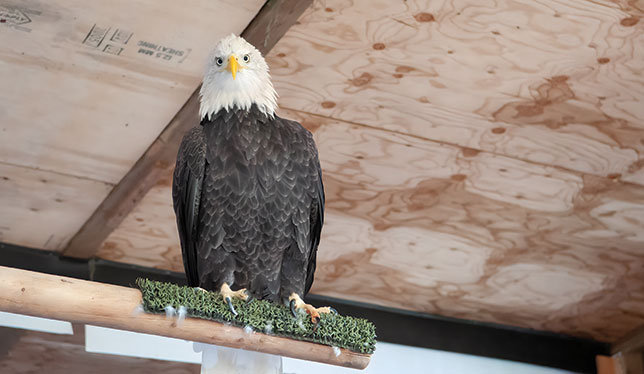Fiep De Bie remembers the date well: Oct. 26, 2021. A bald eagle that had presumably been struck by a car was brought to the Atlantic Veterinary College (AVC) at the University of Prince Edward Island. Ms. De Bie, a wildlife technician in the zoo, exotics and wildlife service at the AVC, was one of the first to see the bird.
“We cleaned him up as good as we could, but he looked pretty bad,” she recalled.
The eagle was the 450th animal the service had seen that year – thus, he became known as 450.
Lara Cusack is a veterinarian with the Wildlife Service and she makes it clear that the bird didn’t have a “name” until much later in his story. “The goal with us is always to get them back to the wild,” said Dr. Cusack. “So we don’t talk to them, we don’t interact with them. …We basically try to minimize all human interactions so that when they go back to the wild, they are not habituated to people. So for the entire time he was here, we called him 450.”

From the start, things weren’t looking good for 450. He had a spinal fracture. The only option was surgery. Although it was commonly done on dogs and cats, this spinal surgery had only ever been done once before on a bird, a penguin, 20 years earlier – and the penguin had died. The wildlife service fundraised to cover treatment costs and the operation happened that November.
“That first ‘Hurray!’ moment for all of us was when he was able to stand, because that meant the pressure was now off the spinal cord,” said Lara Cusack, a veterinarian at AVC.
Nevertheless, 450 still had a long recovery ahead. “A bird that can’t fly perfectly is a bird that can’t go back to the wild,” said Dr. Cusack. When it was clear after more than a year that he couldn’t be released, the team realized his temperament would suit a home where he could become an ambassador for his species.
Enter Hope for Wildlife, a wildlife rehabilitation and education outfit in Seaforth, Nova Scotia, that has an ongoing educational relationship with AVC. Founder and director Hope Swinimer’s team went to work building a new enclosure for 450. He arrived there early in January 2023.
“I’m hoping [he] will have a really good life,” Ms. Swinimer said. “Once he settles in, we’re really gonna focus on his enrichment and giving him the things he needs to be comfortable and happy…. We’re hoping it’ll be a win for [450] and it will be wonderful for the general public who visit us.”
“We hope he lives a long and fruitful eagle life with Hope for Wildlife,” said Dr. Cusack, “and that we learn to do better by wildlife in the natural world.”
Kudos to UPEI & thanks to Hope for Wildlife. 450 is a fortunate eagle!